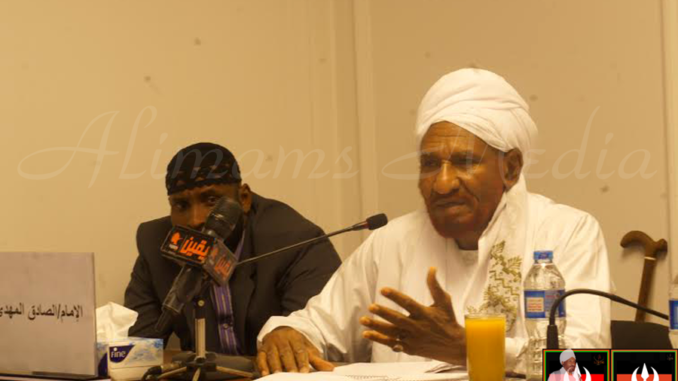
Oxford, 2 May 2003.
Introduction:
In theory, the prospects for peace in Sudan are excellent because,
- The parties to the conflict realize that outright victory in the conflict for either side is not possible.
- There is widespread war fatigue among their grassroots.
- The Islamicist ideology, which was responsible for deepening the conflict has receded.
- The opposite Secularist alternative has moderated.
- There are generally acceptable compromise ideas in place.
- Both armed parties realize that in the current National, Regional and International context there is no room for a Totalitarian system to succeed the present setup.
- New Partnership for Development in Africa NEPAD advocates the principles of Peace, Democracy and development and makes them conditions for developmental aid.
- The Cotonou Partnership Agreement between the Members of the African, Caribean and Pacific APC group of States and European Community, sees peace, security and stability, respect for human rights, democratic principles and the rule of law and good governance conditions for development; and makes them conditions for Afro- European relations.
- The UNDP Report about Arab Human Development 2002 make partnership, accountability and transparency conditions for Human Development.
- Internationally, Peace and Democracy have become necessary conditions for the drive against the sources of Terrorism. However, the practical prospects for peace in the Sudan are wanting. They will not be improved unless certain radical conditions are fulfilled. Pressure towards the fulfillment of these radical conditions has to come from internal popular forces, the International community and the mushroom growth of study centers, peace forums and initiatives, which have shown great concern for conflict resolution in the Sudan and contributed excellent analysis and ideas.
The following seven points present my argument and conclusions:
FIRST POINT: The four confidence building measures of Mr. Dan Forth (outplayed in January 2002), the Civilian Protection Monitoring Team CPMT (March 2002), the Mashakos Protocol (July 2002), the Memorandum of Understanding MOU (October 2002), the positive UN resolution in favor of Human Rights improvement in Sudan (April 2003), the statement by the US President on 22nd April 2003 that the GOS and SPLM are negotiating in good faith, the summit meetings between the leaders of the two parties to the armed conflict and the persistent efforts of the great numbers of the non-governmental centers and groups, have created a rich culture of conflict resolution in Sudan and created a positive climate for a successful Peace Process in Sudan. The parties to the conflict have indicated their approach to the peace process, and all the country’s political forces have expressed their positions towards the rising expectations. The shifting sands of politics may under certain circumstances consolidate the process or under different conditions derail it.
SECOND POINT: Numerous Sudanese parties have negotiated with the present Regime in Sudan. The considered judgement of all of them is that the Regime reflects the same characteristics of its likes. Authoritarian Regimes desist from any real devolution of power. They may, in certain circumstances make concessions on general principles. They withdraw them when it comes to programs and particulars. They offer participation in Government, but keep it at a ministerial level where the ministers remain guests in their own ministries. They even penetrate their negotiating partners to weaken them. However, this time round they are negotiating with a party of commensurate military prowess and in the presence of a Third Regional and International Party. So far their approach has been as follows:
- An attempt to reach a bilateral sharing of power to the exclusion of others.
- To swallow a secularist South, in exchange for a theocratic North, with a façade of central power in which the SPLM/A will be their junior partner.
- To accommodate American interests in terms of cooperation in the war on Terrorism and even access to Sudan’s oil wealth.
Such a deal might have been feasible twenty months ago. It is no longer feasible and would constitute an obstacle to Conflict Resolution in the Sudan. Why? What has changed to make it unworkable?
THIRD POINT: The following points have changed the political map of the Sudan and so the prospects of the different parties:
- Since 1999 the Regime has witnessed a continuous erosion of its political power base, namely:
- The break with the PC (Dr. TURABI’s Party) has siphoned away many youth and women enthusiasts. It deprived the Regime of its intellectual guru. The fact that the break centered on the issue of the struggle for power, disappointed the idealists and the puritans, the spritual core of the Regime.
- Then came the break with the Justice Party. They are a very influential cadre in the Regime who represent regional symbols of participation. Their estrangement chips away at the National Character of The National Congress Party.
- Then the memorandum about the creation of a Northern Sudanese Liberation Movement led by Dr. ALTAYEB MUSTAFA –general manager of the National Corporation for Communication- indicated an ideological schism within the Regime about the future of the Sudan. They regard the South as a conduit of foreign involvement, and a means of abdicating from the ISLAMICIST movement’s principles.
- The emergence of new political forces in the Sudanese political theatre. Forces which represent protest against the Regime’s cultural program.They are:
- q The Sudan Civil project which established the Kampala Forum in coordination with Pan African Movement, it represents a union of all Sudanese Churches plus several civil society organizations. They have a specific political program, namely, a secular Sudan, and Self Determination for the South and the Marginalized Territories of the Sudan (The Kampala-I Feb.1999, the Kampala-II July 2000, the Kampala- III March 2002 and the Kamapala-IV November 2002 )
- q The formation of the Sudan Union of the Marginalized Majority (SUMM), April 2003. This represents a broad based protest with ethnic and cultural overtones.
- q Although the Umma party has led the way towards a comprehensive Political Agreement to be negotiated and reached by peaceful means, the negotiations with the Regime have gone sour. The Umma Party has mobilized a large section of the Sudanese community around the National Agenda wich calls for just peace, and genuine Democratic Transformation. The Umma Party(UP) has achieved the following:
- Reorganized itself, held its sixth National Congress, and formed a national, democratic political organization.
- Defined in a comprehensive way the terms for a comprehensive political agreement, and effected a mass mobilization in favour of these terms.
- Sought to reach an All-Party National Accord. This process has covered a long milage and should soon be completed.
- The U.S Sudan Peace Act has not gone. It remains as a continuous watch for behavior along certain lines. The Report to Congress and the expected policy lines must not be seen as a bill of approval. It requires the fulfillment of certain conditions.
- The interest of the U. N . Human Rights Commission in the Sudan situation continues, and with it the need to fulfill certain standards. The fact that the Sudan has barely escaped condemnation this time requires continuous effort to avoid any relapse.
- The events in DARFUR which have reached a high point in April 2003 represent a great Regime failure. From TINA, to JEBEL MARRA,to AL FASHIR, they represent an organized political challenge by military means. Several political forces in the Sudan have either participated in the events, or supported them. Whoever have been the actual actors, a wide section of opinion in Sudan sympathized with their political aims while rejecting their violent means. The GOS has put a premium on the use of force. It said that it only negotiates with arms bearers. The example of drawing attention only in proportion to the use of arms is there for all to see and imitate.
- Regionally, it seems that the Regime has no Arab strategic allies. It has two sowrn opponents: Uganda because it has an ethnic African vision of Africa, and Eritrea because it considers the Sudan in axis with Ethiopia against it.
- The fall back from Iraq means a more assertive U.S international policy. Both U.S anti-terrorism programs, and U.S credibility favour a greater emphasis on Democracy in the Middle East and Africa.
The IGAD negotiators have got to accommodate their positions to these developments. These developments make the bipartisan option irrelevent. No party in its right mind can ignore the above described political developments. In fact, the foreward looking forces within the negotiating parties will seek to update their positions to cater for them.
FOURTH POINT: Some reactionary elements within the negotiating parties may find the said developments disturbing and hope for a resort to square one. This reactionary nostalgia will not do:
- The popular drive for Peace and Democratization have passed the point of no return. The UP (Umma Party) has proposed a 31 point Charter of National Accord (attached). It has surveyed all the relevant points and found that they fall in three categories: Points which have been generally agreed in the KENYA negotiations, but there is need for greater specification, points which have been issues of disagreement, and points which have to be agreed but not yet discussed. We have proposed a compromise resolution of all the three categories. This Charter when signed by all the country’s political forces will provide criteria to judge the positions of the negotiating parties. It will constitute a type of “National Peace Act”.
- Apart from the U.S whose Peace Act involves some defects, we have proposed to the European Union to come up with a moderate “Peace Act” of their own to lay down criteria which will positively influence the drive towards conflict resolution in the Sudan.
The peace negotiations will have to face an army of ”Peace Acts” with different rewards and punishments. Far from an attempt to fall back to square one, the enlightened leadership within all the Sudanese political spectrum will be falling over backwards to move forward, and not to be seen to obstruct.
FIFTH POINT: In the National, Regional and International circumstances, which prevail, a breakthrough compromise program cannot be safely resisted by any political group in the Sudan. However, no one can rule out coup making adventurers who may try to fly in the face of History, if they succeed, they will only make the country prey to fragmentation and foreign intervention.
SIXTH POINT: All Sudanese political forces are required, at this juncture, to take a strategic decision accepting the terms for just Peace and real Democratic Transformation. This Comprehensive Political Agreement can only be reached in a National Constitutional Conference to which the bilateral Kenya process may be considered as necessary first phase.
To reach this terminal, National and International pressure is required. In the circumstances success is probable.
SEVENTH POINT: In contrast to many countries in a similar predicament, Sudan’s political forces and organizations of civil society are relatively well organized and articulate. The Regional and International contributors to the Sudanese Peace Process are well defined and well informed about the different issues, the study groups and centers, which studied the Sudan’s conflicts are serious minded and erudite.
A broad coalition of these forces could bridge the gap between theory and practice and help realize the credible potential of prospects for Conflict Resolution in Sudan.
Thank you for listening.
Al Sadig Al Mahdi
Attachments:
- The proposed Charter of National Accord- in Arabic.
- An executive summary of the Accord –in English.

